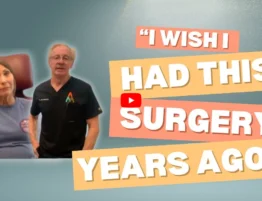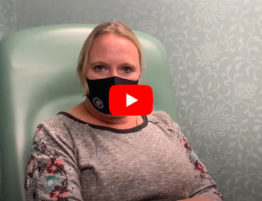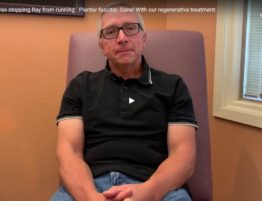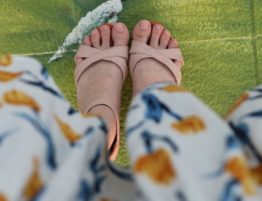
We all start life with a limited number of bone and joint “poker chips” and these are not distributed fairly. Our genetics as passed on by our parents goes a long way to determine how prone we are to chronic tendonitis or arthritis. The different types of activities we do over the years for work and play require tossing a certain number of these chips into the pot, depending on the impact of those activities.
Yoga and bird watching only cost you one or two…bull riding and marathon running can cost you a few more. Today, I would like to share Jim’s story with you, his journey through treatment and how he is using his “poker chips” to live without pain today.
The Achilles Tendon Trouble
Jim is a very active 65 year-old man who had been dealing with chronic pain in his Achilles tendon and in the ball of his foot. The pain was aggravated by running and had even started hurting with just walking. As a long time educator with a master’s degree in physical education, he was accustomed to pushing himself mentally and physically. This problem was starting to significantly limit his numerous hobbies and activities.
“I had a successful collegiate running career with a 4:05 mile, and a 1:49.3 half-mile, averaging about 45-55 miles a week.” says Jim. “And I wanted to continue to live a very active life.”
When I first saw Jim he had already been treating himself with stretching, icing, and massage with little improvement. He had also been seen by another physician who recommended a Platelet Rich Plasma (PRP) injection. That treatment involves drawing blood from a patient and using a centrifuge to separate the plasma (fluid) part from the platelets and other blood cells. This concentrate is then injected into chronically damaged tissue to stimulate healing. Often this type of treatment is referred to as “regenerative therapy” meaning it works by speeding up or stimulating the body’s natural healing process.
The Neuroma Trouble
While Jim had been dealing with the Achilles tendon pain for some time, he also began having worsening pain in the ball of his foot from a neuroma. A neuroma is a chronically damaged and pinched nerve in the ball of the foot. Over time, the nerve becomes swollen which increases the pressure from surrounding structures causing further pain, numbness, and damage.
“I was having trouble just walking a half mile with my wife because the pain would radiate all the way up my leg. I was living on Advil and Advil PM in my duress,” says Jim.
The Solution: Surgery + Regenerative Therapy
To treat a neuroma, many doctors will recommend surgically removing the damaged nerve. However, it can have a high rate of post-op complications including significant scarring and nerve pain from the cut nerve. Some studies have shown almost a 35% incidence of post-surgical pain after this procedure.
My preferred treatment is to “decompress” the nerve rather than remove it. This procedure involves cutting the ligament directly above the nerve rather than the nerve itself. This is similar to a carpal tunnel release in the wrist and results in reducing the pinch on the nerve. This procedure is much less invasive and has a high rate of success for most neuromas. After meeting with Jim and explaining my recommendation, he was totally on board.
“Dr. Overman didn’t promise me a miracle, but I think he knew quite possibly that this would fix all the pain I was experiencing,” Jim says.
The Results
The surgery went very well and involved both the neuroma decompression and PRP injection throughout the painful Achilles tendon to help stimulate the natural healing process. By Jim’s first post-op visit, he was already having less pain, and by the time his stitches were removed, he was chomping at the bit to go golfing (although I have my suspicions that he may have worked in a round or two before official clearance was given).
“Dr. Overman is a brilliant podiatrist and surgeon. The pain is gone. I have no pain.” Jim says. “He didn’t take the nerve out because he didn’t need to. My only wish is that I would have found him earlier.”
The Poker Chips
We also had the conversation about the “poker chip” scenario and how that should impact his decision to keep running. Although he is able to run again, he is now more concerned with preventative maintenance of his bones and joints. Seeing how much the pain had affected his life for more than a year before the surgery led to a re-evaluation. Years of wear and tear can lead to chronic damage that can be difficult to treat.
“Dr. Overman was a collegiate runner just like I was,” says Jim. “He was able to help me see that there were so many other activities I could be doing that would keep me out of pain for years to come.”
These days, you can find Jim out on the golf course, biking, hiking, and going for walks with his wife. “I don’t have any pain now,” says Jim, “And I don’t take that for granted anymore.”
If you are experiencing unresolved foot pain, please come see us! We can help.









Write a comment: